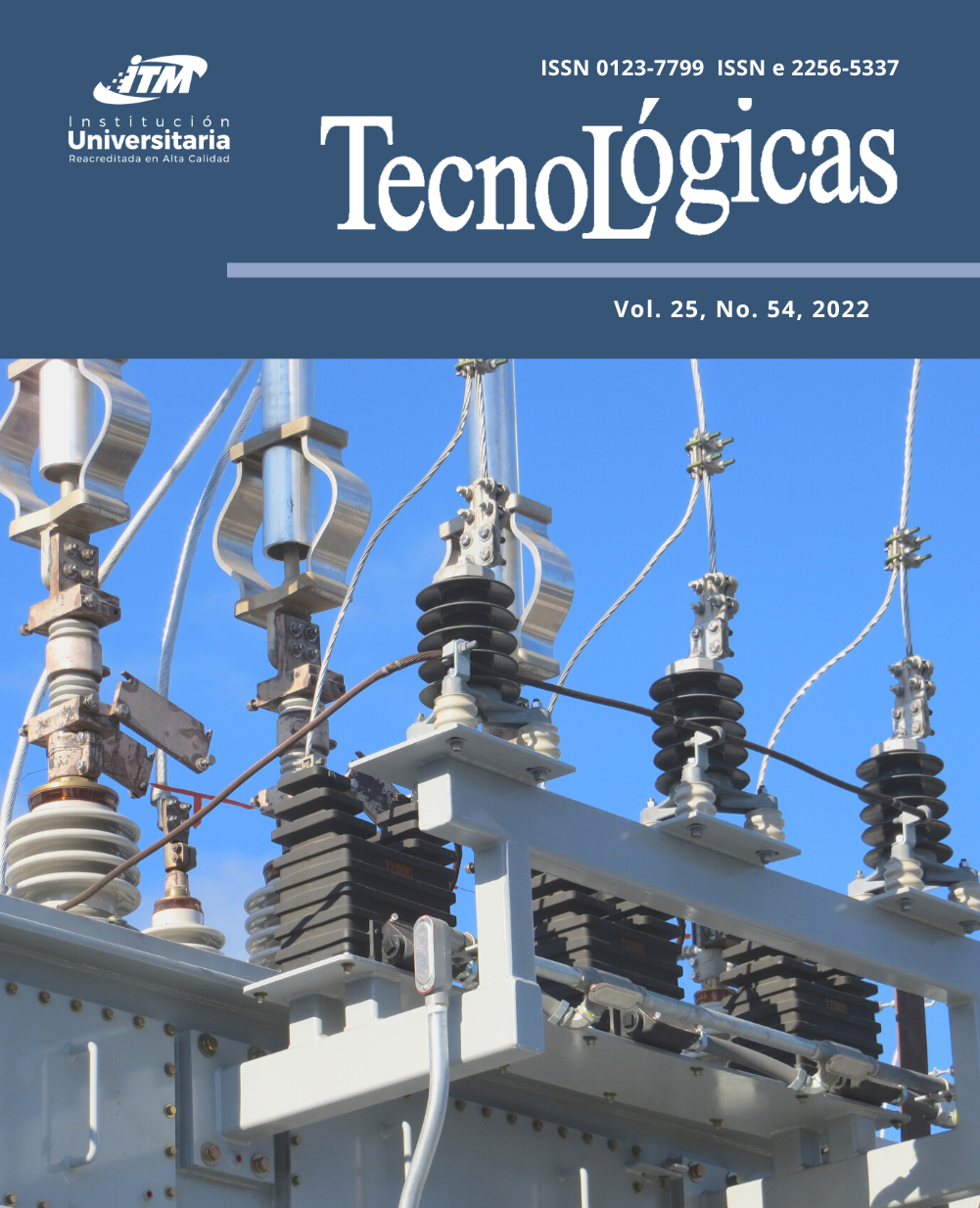Influencia de los parámetros operacionales de carbonización hidrotermal asistida por microondas en la obtención de productos de valor energético: una revisión
Resumen
La agroindustria genera gran cantidad de residuos de tipo orgánico, los cuales son considerados una biomasa apta para aprovechamiento energético. Una de las tecnologías de conversión termoquímica que permite obtener un producto de alto valor energético es la carbonización hidrotermal, la cual puede ser asistida por microondas o por horno convencional. El objetivo de este artículo fue recopilar información sobre la influencia que tienen los parámetros operativos en la obtención de mayores rendimientos y contenidos de carbono del hidrochar en el proceso de carbonización hidrotermal asistida por microondas (MAHTC) y, a su vez, demostrar tal influencia de los parámetros mediante un metaanálisis. Para el metaanálisis se tomó la información bibliográfica recopilada y se evaluó a través de un modelo lineal generalizado tipo mixto. Los resultados del modelo evidenciaron que la temperatura y el tiempo ejercen influencia en el contenido de carbono, mientras que el rendimiento estaría influenciado, principalmente, por el tiempo de reacción. En términos generales, se resalta al parámetro de la temperatura de reacción como el factor más importante en la carbonización hidrotermal, ya que determina las propiedades fisicoquímicas del hidrochar, es decir que con la información aquí presentada se pretende incentivar el aprovechamiento de los residuos agroindustriales para ser transformados en productos de alto valor energético y, de este modo, brindar una solución a la problemática de cambio climático, propiciando el desarrollo sostenible del sector agrícola.
Referencias bibliográficas
A. Savino; G. Solórzano; C. Quispe; M. C. Correal, Perspectiva de la Gestión de Residuos en América Latina y el Caribe, Programa de las Naciones Unidas para el Medio Ambiente, 2018. https://www.unep.org/es/resources/informe/perspectiva-de-la-gestion-de-residuos-en-america-latina-y-el-caribe
R. Rithuparna; V. Jittin; A. Bahurudeen, “Influence of different processing methods on the recycling potential of agro-waste ashes for sustainable cement production: A review”, J. Clean. Prod., vol. 316, p. 128242, Sep. 2021. https://doi.org/10.1016/j.jclepro.2021.128242
Organización de las Naciones Unidas para la Alimentación y la Agricultura, El estado mundial de la agricultura y la alimentación 2019, vol. 32. Organización de las Naciones Unidas para la Alimentación y la Agricultura, 2019. https://doi.org/10.4060/CA6030ES
Organización de las Naciones Unidas para la Alimentación y la Agricultura, Pérdidas y Desperdicios de Alimentos en América Latina y el Caribe, 2016. https://www.fao.org/publications/card/es/c/I5504S/
Organización de las Naciones Unidas para la Alimentación y la Agricultura, El estado mundial de la agricultura y la alimentación 2020, vol. 32. Organización de las Naciones Unidas para la Alimentación y la Agricultura, 2020. https://doi.org/10.4060/cb1447es
The United Nations Environment Programme, “Emissions Gap Emissions Gap Report 2019”, 2019. https://www.unep.org/resources/emissions-gap-report-2019
M. Pateiro et al., “Evaluation of the protein and bioactive compound bioaccessibility/bioavailability and cytotoxicity of the extracts obtained from aquaculture and fisheries by-products”, in Advances in Food and Nutrition Research, Elsevier, 2020, vol. 22, pp. 97–125. https://doi.org/10.1016/bs.afnr.2019.12.002
S. Kamiloglu; M. Tomas; T. Ozdal; P. Yolci-Omeroglu; E. Capanoglu, “Bioactive component analysis”, in Innovative Food Analysis, Elsevier, 2021, pp. 41–65. https://doi.org/10.1016/B978-0-12-819493-5.00002-9
S. Petrulyte; D. Petrulis, “Modern textiles and biomaterials for healthcare”, in Handbook of Medical Textiles, Elsevier, 2011, pp. 1–35. https://doi.org/10.1533/9780857093691.1.3
M. Kumar; A. O. Oyedun; A. Kumar, “A review on the current status of various hydrothermal technologies on biomass feedstock”, Renew. Sustain. Energy Rev., vol. 81, part. 2, pp. 1742–1770, Jan. 2018. https://doi.org/10.1016/j.rser.2017.05.270
Z. Anwar; M. Gulfraz; M. Irshad, “Agro-industrial lignocellulosic biomass a key to unlock the future bio-energy: A brief review”, J. Radiat. Res. Appl. Sci., vol. 7, no. 2, pp. 163–173, Apr. 2014, https://doi.org/10.1016/j.jrras.2014.02.003
T. P. T. Pham; R. Kaushik; G. K. Parshetti; R. Mahmood; R. Balasubramanian, “Food waste-to-energy conversion technologies: Current status and future directions”, Waste Manag., vol. 38, pp. 399–408, Apr. 2015, https://doi.org/10.1016/j.wasman.2014.12.004
A. Pandey; T. Bhaskar; M. Stöcker; R. K. Sukumaran, Recent Advances in Thermo-Chemical Conversion of Biomass. Elsevier, 2015. https://doi.org/10.1016/C2013-0-00403-3
K. Tekin; S. Karagöz; S. Bektaş, “A review of hydrothermal biomass processing”, Renew. Sustain. Energy Rev., vol. 40, pp. 673–687, Dec. 2014. https://doi.org/10.1016/j.rser.2014.07.216
D. A. Iryani; S. Kumagai; M. Nonaka; K. Sasaki; T. Hirajima, “Hydrothermal carbonization kinetics of sugarcane bagasse treated by hot compressed water under variabel temperature conditions”, ARPN J. Eng. Appl. Sci., vol. 11, no. 7, pp. 4833–4839, Apr. 2016. http://repository.lppm.unila.ac.id/1111/1/jeas_0416_4033_Publikasi%20Dewi.pdf
M.-M. Titirici; M. Antonietti; N. Baccile, “Hydrothermal carbon from biomass: a comparison of the local structure from poly- to monosaccharides and pentoses/hexoses”, Green Chem., vol. 10, no. 11, p. 1204, May. 2008. https://doi.org/10.1039/b807009a
R. Bolaños Díaz; M. Calderón Cahua, “Introducción al meta-análisis tradicional”, Rev. Gastroenterol. del Perú, vol. 34, no. 1, pp. 45–51, Ene. 2014.
http://www.scielo.org.pe/scielo.php?script=sci_arttext&pid=S1022-51292014000100007&lng=es&nrm=iso
The R Development Core Team, R: A Language and Environment for Statistical Computing. Proyecto GNU, 2008. http://softlibre.unizar.es/manuales/aplicaciones/r/fullrefman.pdf
H. Sayğılı, “Hydrothermal synthesis of magnetic nanocomposite from biowaste matrix by a green and one-step route: Characterization and pollutant removal ability”, Bioresour. Technol., vol. 278, pp. 242–247, Apr. 2019. https://doi.org/10.1016/j.biortech.2019.01.103
X. Chen; Q. Lin; R. He; X. Zhao; G. Li, “Hydrochar production from watermelon peel by hydrothermal carbonization”, Bioresour. Technol., vol. 241, pp. 236–243, Oct. 2017. https://doi.org/10.1016/j.biortech.2017.04.012
L. Cao et al., “Microwave-assisted low-temperature hydrothermal treatment of red seaweed (Gracilaria lemaneiformis) for production of levulinic acid and algae hydrochar”, Bioresour. Technol., vol. 273, pp. 251–258, Feb. 2019. https://doi.org/10.1016/j.biortech.2018.11.013
T. Werpy; G. Petersen, “Top Value Added Chemicals from Biomass: Volume I -- Results of Screening for Potential Candidates from Sugars and Synthesis Gas”, Office of Scientific and Technical Information, Golden, Aug. 2004. https://doi.org/10.2172/15008859
J. Xu; J. Zhang; J. Huang; W. He; G. Li, “Conversion of phoenix tree leaves into hydro-char by microwave-assisted hydrothermal carbonization”, Bioresour. Technol. Reports, vol. 9, p. 100353, Feb. 2020. https://doi.org/10.1016/j.biteb.2019.100353
Y. Gao; J. Remón; A. S. Matharu, “Microwave-assisted hydrothermal treatments for biomass valorisation: a critical review”, Green Chem., vol. 23, no. 10, pp. 3502–3525, 2021. https://doi.org/10.1039/D1GC00623A
L. Zhan; L. Jiang; Y. Zhang; B. Gao; Z. Xu, “Reduction, detoxification and recycling of solid waste by hydrothermal technology: A review”, Chem. Eng. J., vol. 390, p. 124651, Jun. 2020. https://doi.org/10.1016/j.cej.2020.124651
Y. Li et al., “Microwave assisted hydrothermal preparation of rice straw hydrochars for adsorption of organics and heavy metals”, Bioresour. Technol., vol. 273, pp. 136–143, Feb. 2019. https://doi.org/10.1016/j.biortech.2018.10.056
S. E. Elaigwu; G. M. Greenway, “Microwave-assisted and conventional hydrothermal carbonization of lignocellulosic waste material: Comparison of the chemical and structural properties of the hydrochars”, J. Anal. Appl. Pyrolysis, vol. 118, pp. 1–8, Mar. 2016. https://doi.org/10.1016/j.jaap.2015.12.013
J. Remón; J. Randall; V. L. Budarin; J. H. Clark, “Production of bio-fuels and chemicals by microwave-assisted, catalytic, hydrothermal liquefaction (MAC-HTL) of a mixture of pine and spruce biomass”, Green Chem., vol. 21, no. 2, pp. 284–299, 2019. https://doi.org/10.1039/C8GC03244K
T. Longprang; D. Jaruwat; P. Udomsap; N. Chollacoop; A. Eiad-ua, “Influence of Acid Additive on Nanoporous Carbon Materials via HTC for Catalyst Support”, Mater. Today Proc., vol. 23, part. 4, pp. 762–766, Jul. 2020. https://doi.org/10.1016/j.matpr.2019.12.271
W.-H. Chen; S.-C. Ye; H.-K. Sheen, “Hydrothermal carbonization of sugarcane bagasse via wet torrefaction in association with microwave heating”, Bioresour. Technol., vol. 118, pp. 195–203, Aug. 2012. https://doi.org/10.1016/j.biortech.2012.04.101
S. Nizamuddin et al., “An overview of microwave hydrothermal carbonization and microwave pyrolysis of biomass”, Rev. Environ. Sci. Bio/Technology, vol. 17, pp. 813–837, Dec. 2018. https://doi.org/10.1007/s11157-018-9476-z
L. Suárez; I. Benavente-Ferraces; C. Plaza; S. de Pascual-Teresa; I. Suárez-Ruiz; T. A. Centeno, “Hydrothermal carbonization as a sustainable strategy for integral valorisation of apple waste”, Bioresour. Technol., vol. 309, p. 123395, Aug. 2020. https://doi.org/10.1016/j.biortech.2020.123395
A. Méndez; G. Gascó; B. Ruiz; E. Fuente, “Hydrochars from industrial macroalgae ‘Gelidium Sesquipedale’ biomass wastes”, Bioresour. Technol., vol. 275, pp. 386–393, Mar. 2019. https://doi.org/10.1016/j.biortech.2018.12.074
J. Cai; B. Li; C. Chen; J. Wang; M. Zhao; K. Zhang, “Hydrothermal carbonization of tobacco stalk for fuel application”, Bioresour. Technol., vol. 220, pp. 305–311, Nov. 2016. https://doi.org/10.1016/j.biortech.2016.08.098
L. Azaare; M. K. Commeh; A. M. Smith; F. Kemausuor, “Co-hydrothermal carbonization of pineapple and watermelon peels: Effects of process parameters on hydrochar yield and energy content”, Bioresour. Technol. Reports, vol. 15, p. 100720, Sep. 2021. https://doi.org/10.1016/j.biteb.2021.100720
O. F. Cruz Jr; J. Silvestre-Albero; M. E. Casco; D. Hotza; C. R. Rambo, “Activated nanocarbons produced by microwave-assisted hydrothermal carbonization of Amazonian fruit waste for methane storage,” Mater. Chem. Phys., vol. 216, pp. 42–46, Sep. 2018. https://doi.org/10.1016/j.matchemphys.2018.05.079
Z. Liu; A. Quek; S. Kent Hoekman; R. Balasubramanian, “Production of solid biochar fuel from waste biomass by hydrothermal carbonization”, Fuel, vol. 103, pp. 943–949, Jan. 2013. https://doi.org/10.1016/j.fuel.2012.07.069
J. Zhang et al., “Process characteristics for microwave assisted hydrothermal carbonization of cellulose”, Bioresour. Technol., vol. 259, pp. 91–98, Jul. 2018. https://doi.org/10.1016/j.biortech.2018.03.010
E. T. Kostas; D. Beneroso; J. P. Robinson, “The application of microwave heating in bioenergy: A review on the microwave pre-treatment and upgrading technologies for biomass”, Renew. Sustain. Energy Rev., vol. 77, pp. 12–27, Sep. 2017. https://doi.org/10.1016/j.rser.2017.03.135
M. F. Zulkornain et al., “Microwave-assisted Hydrothermal Carbonization for Solid Biofuel Application: A Brief Review”, Carbon Capture Sci. Technol., vol. 1, p. 100014, Dec. 2021. https://doi.org/10.1016/j.ccst.2021.100014
S. E. Elaigwu; G. M. Greenway, “Chemical, structural and energy properties of hydrochars from microwave-assisted hydrothermal carbonization of glucose”, Int. J. Ind. Chem., vol. 7, pp. 449–456, Dec. 2016. https://doi.org/10.1007/s40090-016-0081-0
S. E. Elaigwu; G. M. Greenway, “Microwave-assisted hydrothermal carbonization of rapeseed husk: A strategy for improving its solid fuel properties”, Fuel Process. Technol., vol. 149, pp. 305–312, Aug. 2016. https://doi.org/10.1016/j.fuproc.2016.04.030
K. Kang et al., “Microwave-assisted hydrothermal carbonization of corn stalk for solid biofuel production: Optimization of process parameters and characterization of hydrochar”, Energy, vol. 186, p. 115795, Nov. 2019. https://doi.org/10.1016/j.energy.2019.07.125
M. Guiotoku; C. R. Rambo; F. A. Hansel; W. L. E. Magalhães; D. Hotza, “Microwave-assisted hydrothermal carbonization of lignocellulosic materials”, Mater. Lett., vol. 63, no. 30, pp. 2707–2709, Dec. 2009. https://doi.org/10.1016/j.matlet.2009.09.049
Y. Shao; Y. Long; H. Wang; D. Liu; D. Shen; T. Chen, “Hydrochar derived from green waste by microwave hydrothermal carbonization”, Renew. Energy, vol. 135, pp. 1327–1334, May 2019. https://doi.org/10.1016/j.renene.2018.09.041
L. Kumle; M. L.-H. Võ; D. Draschkow, “Estimating power in (generalized) linear mixed models: An open introduction and tutorial in R”, Behav. Res. Methods, vol. 53, pp. 2528–2543, Dec. 2021. https://doi.org/10.3758/s13428-021-01546-0
S. Ferrari; F. Cribari-Neto, “Beta Regression for Modelling Rates and Proportions”, J. Appl. Stat., vol. 31, no. 7, pp. 799–815, Aug. 2010. https://doi.org/10.1080/0266476042000214501
M. E. Brooks et al., “glmmTMB Balances Speed and Flexibility Among Packages for Zero-inflated Generalized Linear Mixed Modeling”, R J., vol. 9, no. 2, pp. 378–400, 2017, https://doi.org/10.32614/RJ-2017-066
Descargas
Derechos de autor 2022 TecnoLógicas

Esta obra está bajo una licencia internacional Creative Commons Atribución-NoComercial-CompartirIgual 4.0.
| Estadísticas de artículo | |
|---|---|
| Vistas de resúmenes | |
| Vistas de PDF | |
| Descargas de PDF | |
| Vistas de HTML | |
| Otras vistas | |
Datos de los fondos
-
Instituto Tecnológico Metropolitano
Números de la subvención 21112 -
Universidad de La Frontera
Números de la subvención 11180752









